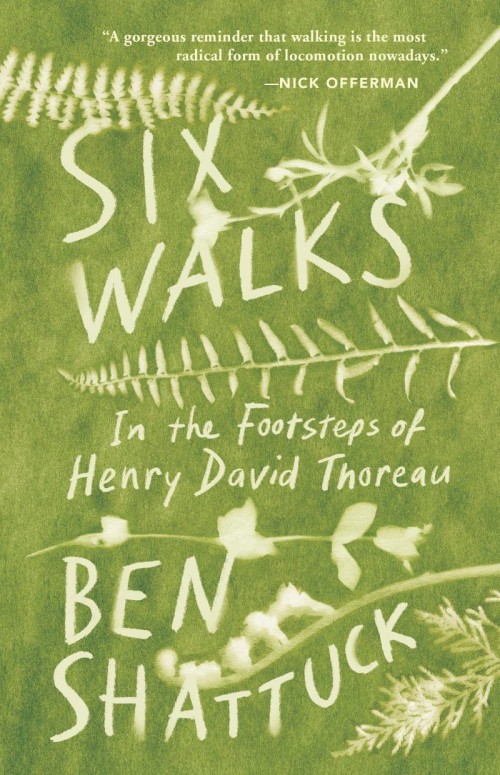by Ben Shattuck
Tin House, 2022
“Without a plan, with only an impulse to walk,” is how Ben Shattuck set off on the first of the journeys he shares in Six Walks in the Footsteps of Henry David Thoreau. At the time, Shattuck was having nightmares of his past girlfriend, he was living on the southern coast of Massachusetts, and he happened to be reading Thoreau’s Cape Cod. Shattuck’s impromptu first walk followed a route Thoreau had taken on one of his visits to the Cape.
“Before I walked out the door that morning, I also put a notebook in my backpack, not because I ever journaled or made sketches, but because Henry had,” he writes. “I wanted to try someone else’s habits for a few days.”
While Shattuck “felt no transcendent experience” on that walk, it helped with his sleepless nights, so he followed it up with two more walks, more or less in Thoreau’s footsteps: to Mount Katahdin in Maine and Wachusett Mountain in Massachusetts – about 170 years after Thoreau had visited those places. Later, he went on three more journeys, including canoeing with a friend in Maine’s Allagash Wilderness Waterway.
With an observant eye, a gift for talking with strangers, and an appreciation of the natural world, Shattuck reveals his process of healing and self-discovery through his physical journeys. Blending his own stories about people and places with some of Thoreau’s stories, descriptions, and reflections, Shattuck examines how therapeutic walking proved to be for both of them.
Shattuck illustrates how much travel and our society have changed. While it took Thoreau more than a week to get to the base of Katahdin from his home in eastern Massachusetts, Shattuck drove there from the Maine coast in an afternoon. The night before climbing Katahdin, Thoreau and his companions cut cedar twigs for bedding, and on the mountain experienced “primeval, untamed, and forever untamable Nature.”
Thoreau wrote, “The tops of mountains are among the unfinished parts of the globe,” and thought it was “a slight insult to the gods to pry into their secrets, and try their effect on our humanity.” Shattuck has a different, more crowded, and less pristine Katahdin experience: “‘Seriously?’ a guy standing beside me on the summit said, looking at his phone. ‘No service?’”
The book is divided into two distinct parts. During the first three walks, Shattuck is working himself out of distress and focuses on healing. In the last three journeys, he has fallen in love, is engaged, and is an expectant father; he is happier and optimistic.
The longest and the strongest section of the book is not actually a walk, but rather a canoe trip Shattuck takes into the Allagash wilderness, which Thoreau visited in 1857. The second to the last of Shattuck’s trips, this one shows his personal growth. Shattuck considers his relationships with friends and family and sometimes learns from Thoreau’s relationships. Thoreau’s lifelong friend and fellow botanist, Ed Hoar, went with him to Maine; he was six years younger than the 40-year-old Thoreau, but couldn’t keep up with him. Although Hoar clearly looked up to Thoreau and was impressed by his energy and curiosity, Shattuck shares a sad discovery Hoar makes years later:
…only after Henry died – five years after they went to Maine together – did Ed have a startling realization: “I have just finished reading Thoreau’s Winter,” Ed wrote in a letter. “I have greatly regretted that I did not know Thoreau better.” We can spend hours, days, months, maybe a lifetime with each other, Ed was realizing, without asking the only questions that matter. They had shared botany and ornithology instead of intimacy, and now Henry was gone.”
In that, Shattuck sees a lesson for us all. Echoing Thoreau in a contemporary context, Shattuck presents walking in woods or on a beach – or canoeing on a lake – as opportunities to reflect, to heal, and to get to know ourselves and each other better.


